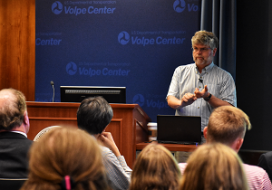Autonomous Vehicles That Include Risk in Their Decision Making
The promise of transportation automation seems to become more and more fulfilled each day. Today’s automobiles that keep themselves in their lane and maintain safe speeds and distances—even in stop-and-go traffic—have recently been joined by successful tests of flying delivery drones.
However, increasing automation levels eventually requires a vehicle to be able not only to control its own maneuvering and detect other vehicles and obstacles, but also to predict what other vehicles could be expected to do as well as to be able to plan and react to other vehicle’s unexpected maneuvering.
Professor Brian Williams, MIT’s Bisplinghoff Professor of Aeronautics and Astronautics, recently spoke as part of the U.S. DOT Volpe Center’s Our New Mobility Future speaker series. His research concentrates on the creation of long-lived autonomous systems that are able to explore, command, and diagnose and repair themselves using fast, online reasoning. Referred to as model-based autonomy, Prof. Williams’ focus is on risk-aware systems whose actions operate within user-specified risk tolerances.
Safe and Simple Transportation Automation
Dr. William’s indicated that there are “two issues that have been central for us, which are being able to provide systems that are assisting you…and the issue of safety—and often we end up making decisions which are a bit too risky. We need to make these systems to be safer…and we still want them to be simpler to work with.”
This can be enabled by artificial intelligence (AI) systems that help at tasks and are collaborative, easy to understand, aware of risks, proactive, and efficient. His work includes allowing the AI system to consider a certain level of risk, which can be set based on the user, to allow for more human-like responses in an AI-controlled vehicle.
Watch a video highlight about autonomous systems from Williams' talk as part of the Volpe Center's 2019 speaker series, "Our New Mobility Future."
A Flying Car for Everyone
One demonstration of planning and risk acceptance can be seen in his notional flying-car controller known as personal transportation system, or PTS. The PTS flying car verbally interacts with its passenger by maintaining a collaborative dialogue. It also manages risk taking, monitors for circumvented goals and activities, and creates and selects alternative backup flight plans.
This interactive system is one way in which humans and robots can intuitively work to refine goals and cooperate on tasks.
Supporting Automated Automobiles with Planning and With Rapid Decision Making
Two other projects provide automation tools for planning (strategic) and reacting (tactical) operations for automobiles.
“You want autonomous systems both to be able to understand the intention and the likely behavior of the cars around you and you also want to be able to behave in the style that is appropriate to that area,” Williams said. “Our problem is that we want to make driving both less stressful and safer.”
The car then becomes responsible for safe maneuvering, but within the context of its environment and the situation. Williams’ tactical tool predicts possible trajectories for each surrounding vehicle based on that vehicle’s prior maneuver sequences, then determines likelihoods for each and ultimately determines its own maneuvering based upon these and within the user-defined risk tolerance. The system also keeps an alternative backup plan, which it continuously updates.
These methods of guiding autonomous systems in terms of goals, and enabling multi-robot and human-robot collaboration could someday allow for vehicles that are autonomous and safe, but also, with the introduction of user-configured risk settings, perform and respond in much the same, familiar way in which we would operate them.

